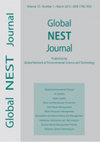超声辐照对水和废水的消毒研究进展
IF 1.2
4区 环境科学与生态学
Q4 ENVIRONMENTAL SCIENCES
引用次数: 49
摘要
众所周知,传统上用于水和废水消毒的氯及其化合物与一些有机物发生反应,形成有害人类健康的不良副产物,称为消毒副产物(DBPs)。在许多国家,为废水再利用对氯化副产物如三卤甲烷设定了非常严格的限制。因此,应评估使用不同的氧化/消毒系统作为氯的可能替代品。超声(US)最近被发现在这方面是有效的。本工作的目的是回顾美国主要的消毒研究,指出超声波在实验室规模和中试规模上对不同细菌(总大肠菌群、大肠杆菌、铜绿假单胞菌、枯草芽孢杆菌、酿酒酵母菌、肺炎克雷伯菌)灭活方面的作用及其机制。为此,对几个实验结果进行了讨论,并对关注的焦点和遇到的问题进行了总结。综述了联合氧化过程中气蚀现象的加剧,指出了其主要优点和不足,为今后的研究和大规模高效操作提供了参考。本文章由计算机程序翻译,如有差异,请以英文原文为准。
WATER AND WASTEWATER DISINFECTION BY ULTRASOUND IRRADIATION- A CRITICAL REVIEW
It is well known that chlorine and its compounds, traditionally utilized for water and wastewater disinfection, react with some organic matter to form undesirable by-products, hazardous to human health, known as Disinfection By-Products (DBPs). In many countries very stringent limits for chlorination by-products such as trihalomethanes were set for wastewater reuse. Accordingly, the use of different oxidation/disinfection systems should be evaluated as possible alternative to chlorine. Ultrasound (US) was recently found to be effective for this purpose. Aim of this work is to review main US disinfection studies, pointing out ultrasound mechanisms as well as its effects in terms of different bacteria inactivation (Total coliform, Escherichia coli, Pseudomonas aeruginosa, Bacillus subtilis, Saccharomyces cerevisiae, Klebsiella pneumonia) at both laboratory scale and pilot-scale. To this end, several experimental results were discussed and both focal interest points and encountered problems were summarized. Moreover the intensification of cavitation phenomena by combined oxidation processes was overviewed and main advantages and disadvantages were pointed out, in order to address future research and promote efficient large scale operations.
求助全文
通过发布文献求助,成功后即可免费获取论文全文。
去求助
来源期刊

Global Nest Journal
环境科学-环境科学
CiteScore
1.50
自引率
9.10%
发文量
100
审稿时长
>12 weeks
期刊介绍:
Global Network of Environmental Science and Technology Journal (Global NEST Journal) is a scientific source of information for professionals in a wide range of environmental disciplines. The Journal is published both in print and online.
Global NEST Journal constitutes an international effort of scientists, technologists, engineers and other interested groups involved in all scientific and technological aspects of the environment, as well, as in application techniques aiming at the development of sustainable solutions. Its main target is to support and assist the dissemination of information regarding the most contemporary methods for improving quality of life through the development and application of technologies and policies friendly to the environment
 求助内容:
求助内容: 应助结果提醒方式:
应助结果提醒方式:


